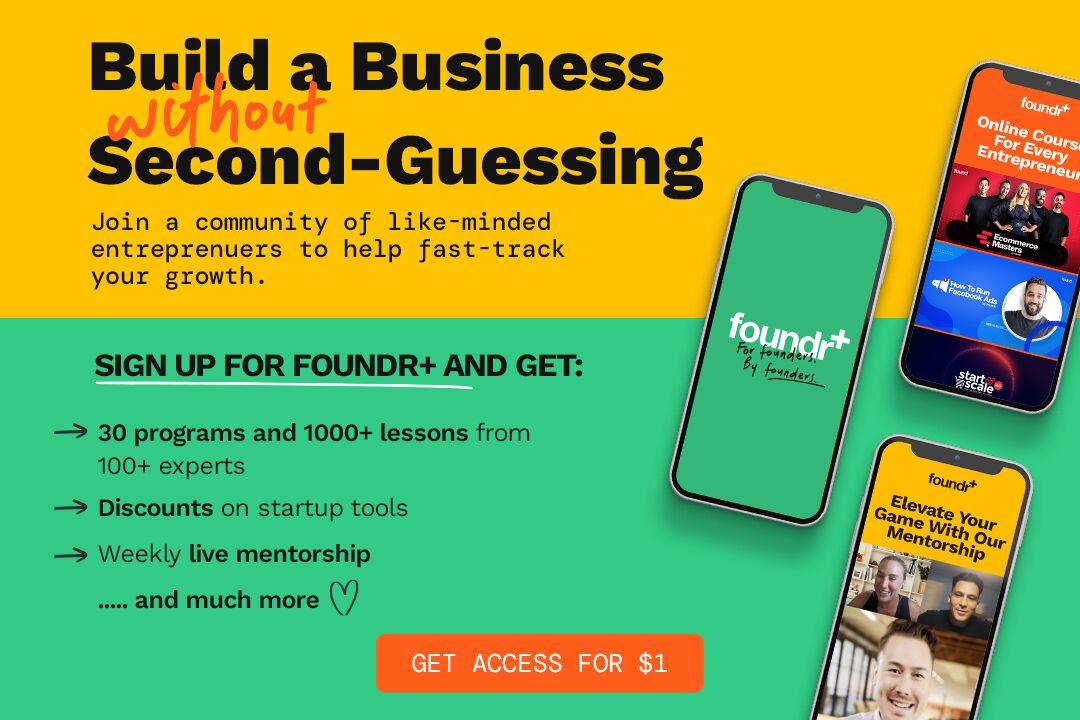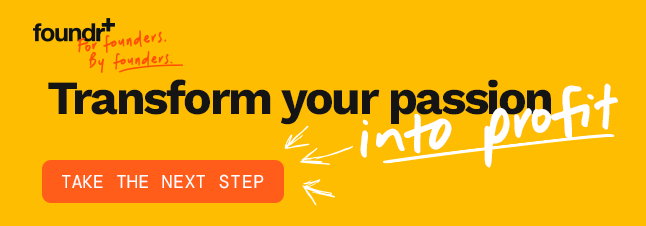Your brilliant idea has no startup funding to back it up.
Sound familiar?
Maybe you’ve chosen the right business model, locked down a co-founder, and drawn up a goal pyramid to outline your first steps.
But there’s still that one big problem: you lack funding.
You need to learn your best options on how to fund a startup. Here’s a quick guide to get you started on getting funding for a startup business.
If you’re just not sure where to begin, and always wanted to see a clear-cut menu of funding options out there in this modern world of startups, this post is for you.
Types of Startup Funding
8 Funding Options for Your Startup
There are costs and benefits for each of the 8 most common types of startup funding. Let’s break them down.
1. Self-Funded (Bootstrapped)
We know that’s not what you wanted to hear, nor is it quite on point with the purpose of this article. Technically, this isn’t really a source of funding. You’re just paying for it yourself with your hard-earned cash, minimizing expenses such that you can still cover bills.
But this hard medicine is what you need to accept when it comes to funding: It will be much harder to convince someone, to take a chance with their money on your idea if you haven’t done the same first.
That means working on your project as a side hustle, self-funding it as much as possible, and burning the midnight oil to cover labor yourself. Or, that might mean saving up enough money so you can have a few months of runway, building out the basis for your idea before seeking out external funding.
And in doing this, you’re certainly not alone. Alongside the burgeoning generation of young entrepreneurs has come a sharp decline in reliance on investors. This means more young entrepreneurs have started building their value through bootstrapping as a primary source of initial funding for their startups.
A lot of people swear by bootstrapping, and for good reason. In fact, foundr itself was a bootstrapped business run by our CEO, who moonlighted in the early days and gradually scaled up the business over time.
Bootstrapping can be extremely gratifying, like building something with your bare hands. And it’s great for first-time entrepreneurs because it proves you can hack it, making it easier to land funds as you launch future businesses.
This is not to say you can’t get your startup funding after you’ve bootstrapped. As Chris Strode of Invoice2go once told foundr:
What I’d tell…every other early entrepreneur out there, is to bootstrap your startup for as long as possible. Founders are often eager to raise funding and take their businesses to the next level, but if you can build a profitable business on your own, you’ll be better positioned to have a favorable conversation with VCs when the time is right. Focus on getting your product right where you want it for your users, and grow it from there.
This method is advantageous as it lets you grow an audience and a user base that will serve as awesome validation and possibly even lead to revenue or profit before you seek out additional funding.
And, of course, you get to keep all the equity.
Want to self-fund your business (or fund it with a business partner)? Follow these steps to fund your startup online business yourself:
- Sacrifice and save: If you’re self-funding, you will need to sacrifice in order to save the funds you need. This looks different for every entrepreneur, but many sell assets such as cars or even homes to help free up cash to start their businesses.
- Find a co-founder you can trust: Regardless of how good you are at saving, sometimes you may simply need more funds. A problem shared is a problem halved, so to solve this, consider bringing on a co-founder. If you’re both investing significantly in the business, though, you’ll need to find someone you can trust. Try friends or business connections, but if you can’t find anyone suitable, consider using websites such as CoFoundersLab.
- Freelance on the side: Starting a business can be an all-consuming, full-time commitment. But if you’re self-funding and you’re concerned you’ll run out of funds, consider freelancing on the side so you can continue to earn an income.
2. Friends and Family
A great piece of startup advice is to start with your inner circle and branch out when it comes to selling your business. In other words, start seeking funding for your business from family and friends.
We know this might send chills down some of your spines. And depending on your relationships with certain friends and family, it’s clearly not an option for everyone.
But the important thing here is taking stock of your existing support network. So often, entrepreneurs try to build something utterly from scratch, as if they have to concoct success within a vacuum. The truth is, most of us have a lifetime of connections all around us, many of whom may have tremendous confidence in us and may even be part of our target audience.
Friends and family are one of the most common sources of funding. Over 38% of entrepreneurs report raising money for their ideas from loved ones’, and over $60BB is raised in startups from family and friends each year. Although these people may not have endless cash to throw your way, the money they are able to support you with may come with many advantages.
Why go the family route?
- Those close to you’re much more likely to take a chance on you and your idea in good faith and lend you money at a low-interest rate or even no interest rate or may ask for a lower amount of equity.
- Money coming from people you know makes you much more committed to success and providing a good return for their money.
- There is a better chance that your friends and family will stay at a supportive distance instead of breathing hungrily down your neck as some investors might.
Remember that you’re looking for a kind of partnership with like-minded people you have an existing connection with. If they truly believe in you and your business, they’ll be excited to get on board, and you couldn’t ask for a better backer than that. And if they’d use your product or service themselves, you’ve also got a potential test market, and early adopter rolled up in one.
At the end of the day, though, this is a very personal decision that needs to be taken seriously. Some of the best startups in the world resulted from friendships… as did some classic disasters. Tread carefully.
Even if you’re looking for funding options for a startup online business (which can cost less money in many cases), if the issue is that you’re simply embarrassed to ask your family and friends to back your startup, then maybe it’s time to rethink your business idea. If you’re shy about going to people who know and love you, it’s not going to be any easier approaching investors.
3. Crowdfunding Platforms
Crowdfunding has rapidly become a premier way for entrepreneurs to get their startups funded. Since platforms like Kickstarter and Indiegogo came on the scene, it has cracked open virtually infinite possibilities for companies to get started.
Long story short, crowdfunding involves getting a large group of people to back your company with relatively small individual contributions. These backers will not always get a say in how your business is operated, depending on the platform, and they collectively share a relatively small risk each, because together they enthusiastically want the project in question to exist.
Even veteran investors like Shark Tank star Barbara Corcoran told Foundr she’s been blown away by the potential of crowdfunding:
The access to capital isn’t at your local bank—it’s online. I would say that at least 40 percent of all the entrepreneurs we met on Shark Tank had already raised a lot of money online through crowdfunding. You can teach yourself how. Analyze successful campaigns. Figure out what works.
This funding model can not only be used to gather up some initial funding but can be used for subsequent fundraising for future products and services. Just for one example chosen completely at random, there’s our first print publication, Founder Version 1.0, which we funded with our first Kickstarter campaign. It went great!
While earning funding through these platforms is incredibly convenient for both financial purposes and public exposure, it can be even more successful if you have a little something already saved up. According to Forbes, having around 25% of your monetary goal already raised before approaching the crowd can help account for relevant fees, while also enticing potential investors to keep the momentum going and the funding coming.
Crowdfunding is a great way to land some cash, but it’s not for the faint of heart. It’s both art and science, and now that it’s such a widespread practice, it takes some real work and even investment of its own to build up and execute a successful campaign.
If you’re interested in using crowdfunding for your startup, start by researching which crowdfunding platform best suits your needs. Look for:
- What types of campaigns was the website designed for
- Whether you have to hit a goal to receive the contributions
- Cost of using the crowdfunding platform
- How the platform integrates with social media
4. Government Grants or Loans
This is an often-overlooked way to get your startup funded.
Many people don’t know that their government may be offering convenient loans or full-on grants for aspiring entrepreneurs in their midst. Because new businesses are a large source of economic growth in industrialized economies, governments have it in their best interests to support the individuals looking to throw their chip into the ring.
Mission-driven organizations are also well-suited to pursuing grant funding, as there are more and more grant programs popping up to support sustainable and socially conscious businesses that have the potential to fuel a regenerative economy.
The downside of grants is that they are highly competitive, and it’s often time-consuming to apply. If you decide to seek out grant funding, choose a grant program that matches your business. It’s better to take a targeted approach rather than casting a wide net. You may also want to consider hiring a consultant who specializes in grant writing to give you the best shot of securing a grant. If you go this route, make sure to ask the consultant for examples of grants they’ve secured for other businesses. You may even want to ask what the grant amounts were relative to what the consultant billed for help writing the grant, so you can decide if the investment is worth the return.
If you’re young (say, under 35 years old) or if you’re creating a new business in science or technology especially, you’ll have a decent shot at landing some funding. What’s more, governments at various levels tend to have their own individual loans available. To find this funding, search at the city, province/state, and federal levels.
5. Business Loans
Business loans provide you with a sum of money that then has to be repaid to the lender with interest. Business loans allow you to maintain equity and control of your business without having to worry about answering to an investor or giving up equity. The downside of business loans is that they come with a short-term cost of capital that needs to be repaid and depending on what type of business loan it is, that cost can get high.
A bank or lender typically makes their decisions based on 3 factors: your time in business, your revenue, and your personal or business credit score. Because a startup by definition doesn’t have much time in business and doesn’t have established business credit, your loan options are more limited.
The Loans You Might Qualify For as a Startup
SBA Loans
SBA loans are backed by the US Small Business Administration, which means the government agency guarantees the loans with the lender in case you default on the loan (think of it like having the US government co-sign your loan). In terms of startup loans, you’re not going to find better terms or interest rates than an SBA loan. There are several different SBA loan options, but the most common is the SBA 7(a).
The tradeoff of these rare and majestic loans is that they come with government-level paperwork and they’re highly competitive. If you choose to go the loan route, it’s worth rolling up your sleeves and trying for an SBA loan.
Short Term Loans
Short term loans are best used when your burn rate is going to put you into a short-term bind. You can use a short term loan to cover inventory for large purchase orders or to make payroll while you wait on payment from a client. Short term payments come with pretty high interest rates because they’re designed to be repaid quickly and that structure allows the lender to still make money from the loan. This small business loan type can be an asset if used wisely, but if you wait to pay it off it can get very expensive very quickly.
Line of Credit
A line of credit allows you to borrow against a predetermined amount of money, repay it, and borrow again as many times as you like over the term of the loan. A line of credit can be a tremendous asset for a startup founder. It gives you the capital you need to finance your startup growth, and you only pay interest on what you borrow. That gives you flexibility and control.
Equipment Loan
An equipment loan is specifically for equipment and can be used for anything from computers to an espresso machine to Square card readers to robotic mining equipment. Because the loan is secured by the equipment itself, this loan is easier to qualify for than other small business loans, and it typically comes with lower interest rates.
Business Credit Cards
Okay, this might surprise you but business credit cards can be a pretty solid way to bootstrap a startup, especially if your capital needs are on the lower end of the spectrum. Business credit cards can be used to finance everything from office supplies to equipment purchases. If you need to make some large purchases and know you’ll have the funds to repay them within 6 months to a year, you could consider a 0% introductory APR credit card. These cards don’t collect any interest during the introductory period, which can make them a clutch option for entrepreneurs, especially those who don’t qualify for other forms of funding.
6. Accelerators
Now we’re getting into the fast lane. If you’re looking for much more than a simple bit of money tossed your way, accelerators are a great option to consider, especially if you’re interested in getting funding for a tech startup.
Accelerators focus on supercharging early-stage business growth by providing short programs (usually 2-4 months long).
They will take applications, dole out funding to those that pass in exchange for equity, plus usually welcome you, your business, and your small team (if you have one) into their program.
The program will often feature an enticing mixture of mentorship and office space. These programs are usually grueling affairs, but if you’re looking to speed up a stage in your business growth, these are the best option. One of the defining factors is their short-term timeframes (incubators, by contrast, tend to last a few years), often culminating in a big presentation session or “demo day.”
These accelerators also tend to present startups with great opportunities to network with other startups and mentors in the business world. In fact, it’s worth noting that accelerators are often much more focused on developing the entrepreneurs or founding teams themselves than a business’s idea.
Applications for accelerators tend to be very competitive, especially for “elite” accelerators such as TechStars and Y Combinator. These two accept only between 1% to 3% of their applicants.
But there are actually quite a few of them, something like 200, and more are always starting. Most of the top accelerators are based in California, including Alchemist, AngelPad, and 500 Startups. But not all of them, and TechStars actually has 20 programs all over the country. Sometimes they’re broad, others are industry-focused.
We suggest starting with local accelerators in your area or looking at niche accelerators targeted to your background or industry.
7. Corporate Partners
Big businesses aren’t what they used to be. The average lifespan of a corporation has plummeted from 24 years in the 1960s to just 12 now. Companies everywhere are looking at ways to transform and innovate, and partnering with your startup might just be the way they do so.
There’s actually a lot of corporate-partner sponsored startups, but you wouldn’t know it, as the partnership isn’t always obvious. One example of a hugely successful startup that began through a corporate sponsorship is Crowdz. Crowdz, which recently completed a Series A funding round for $5.5 million, was created in partnership with Barclays bank.
With corporate partnerships being so lucrative, how do you secure one? We spoke to Carrie Kwan, the founder of Mums & Co, to find out. Mums & Co, a business community for mothers, was created in partnership with IAG insurance.
Carrie was pregnant with her second child when she came across the idea for the company. Through a business connection, she was introduced to someone who would eventually become her corporate partner:
“I was introduced to Phuong Ly, the executive general manager of IAG, and it became evident that we had a mutual interest in reaching the small business community, particularly mothers.”
This mutual interest was extremely beneficial to Carrie, and after deciding it was something she wanted to pursue, she spent a frenetic few months developing an MCP with the backing of IAG. But during that time, she made it clear that it wasn’t just funding that she was after. She wanted a corporate partner who shared her values:
“I was halfway through my second pregnancy when I was in discussions with IAG. But when I raised this, they said, ‘Congratulations. You shouldn’t have to choose between your family and your career.’ This gave me assurance that they shared my values and understood my vision.”
Carrie signed on as a corporate partner for IAG, and the partnership remains strong today, over three years later.
Finding a corporate partner
Want to find a corporate partner to help fund your startup? Follow these steps:
- Build out an MVP: Just like any other investor, a corporate partner will need to understand your vision before partnering with you.
- Network, network, network: Meet everyone in your network, and pitch them our idea. Then ask them who they can refer you to. Repeat, repeat, repeat.
- Connect with other founders who’ve secured a corporate partner: They will be able to provide guidance and possibly introductions.
- Approach corporations directly: Many large companies that have innovation agendas will run incubators, demo days, pitch nights, or networking events. Research corporations that you think share your target audience and values, and see what they have to offer. You can also apply directly to corporate programs through websites such as CoVentured.
8. Investors
Before diving into the intricacies of how they operate, let’s look at the basic definition of an investor.
An investor is a person who has control over some pool of assets, and who invests money into a project in exchange for shares. This means they are not neutral actors in your business.
Investors will have expectations that you use the money in frugal and wise ways, such as for expanding market share through marketing, and not wasting funds on unnecessary expenditures. Second of all, investors by definition expect a return on their investments within a certain period—this return is often a 10x return within up to 5 years. This usually occurs either when your company goes “public” or is sold off.
These expectations can make dealing with investors difficult and stressful. The emphasis will often be placed on growth, and pressure to expand your business asset will be coming from outside you and your team. Still, just as with bootstrapping, there are entrepreneurs who swear by raising capital.
If you’re looking to grow a huge business, accepting investment is usually the only option. Companies that grow large and fast can usually only do so through accepting an injection of investor cash.
Onto the types of investors. They fall into three main groups: personal, venture, and angel investors.
Personal Investors
Personal investors or angel investors are typically in the form of friends and family, as described above.
Venture Capital
Venture Investors, or Venture Capitalists, usually come in the form of experienced investors looking to make large returns by investing in business ideas. Rather than a loan, which a recipient is legally bound to pay back, a VC accepts a certain amount of risk that they won’t make the money back, in hopes that some of their investments pay off huge. Although there is acceptance of risk, they are very selective of who they support.
They will rarely be interested in pouring money into a new/unproven idea and will demand a track record and some demonstrable value before placing money into a business endeavor. Venture capitalists don’t deal in 100s or 1,000s of dollars—we’re talking in terms of millions of dollars invested. If you’re just starting out, a VC is probably not the breed of investor you should seek out.
Angel Investors
Angel Investors are the investors that you’ll be looking for if you’re a burgeoning young business. These are investors who are looking to give relatively small amounts (usually tens or hundreds of thousands) into businesses in exchange for equity and will often be tolerant of other forms of growth besides revenue.
They are often other entrepreneurs who have wealth of their own, as opposed to huge pooled investment funds, and are looking to seed people or businesses they believe in at the early stages of their growth. They sometimes fill a gap between friends and family support and larger forms of investment such as venture capital.
In contrast to Venture capitalists, angel investors may not require a part-ownership of the company. Instead, he or she may request a percentage of return on her/his investment. But, as with venture capitalists, there will be situations where angel investors require ownership and management decisions in your company.
The Basic Categories of Funding
There are two models for funding a startup: that which costs you equity, and that which costs you debt.
There is a third, grants, and gifts, but this is less common for profit-seeking businesses.
Debt as a Form of Funding
Debt, a form of funding so many of us are unfortunately familiar with, is money that you’re obligated to pay back with interest over an agreed-upon time period.
This can be in the form of a bank loan or just racking up a bunch of money on credit cards. The latter is probably the easiest and fastest way to scare up some money, but there’s a reason it’s a bad idea.
Rates are usually terrible, and if you don’t have a lot of cash flow, you can end up saddled with that burden for years. Small business loans are one traditional avenue for funding, but they are often restricted to people with existing cash flow or some kind of collateral to put up.
Offering Equity in Exchange for Funding
Equity, on the other hand, means a percentage of ownership in your business offered up at market value in exchange for money.
This is what investors will typically deal with. Clearly, to offer equity to an investor, you need to have some perceived value or proof of concept to instill confidence.
Grants and Gift Grants
Grants are much more common for endeavors like charities, nonprofits, or social enterprises. Don’t be envious, though, it’s hard work to get a foot in the door with a grantmaker, and often funds come with stringent requirements and oversight.
As far as grand gifts go, well, here’s hoping a bag of money lands on your doorstep. If you’ve ever watched the show Shark Tank this will be familiar to you, as the sharks will often haggle over what kind of stake they get in exchange for the money they’re going to sink into the business.
Entrepreneurs tend to want to reduce the amount of equity they give away because this means lower profits for them in the future. This can also be risky because if more than half of a company’s equity is sold, that means a potential loss of control.
Now, how do you get your entrepreneurial paws on this cash? On to the juicy bits:
Don’t Skip: How to Start a Startup (Advice from Those Who’ve Done It)
Understanding Startup Funding Stages
What the heck is a seed round? Will you need a Series A, B, and C? This financial mumbo jumbo (technical term) can feel intimidating for an aspiring entrepreneur, but it doesn’t need to be. The multiple funding round structure has become more common in recent years, especially in the tech industry. But as tech startups have seen wild success, the model has also spread to other industries as well.
You may not need to know anything about how a Series B works. Many small businesses find the funding they need without going this route. You’ll likely only encounter this if you plan to seek out external investors like an angel investor or venture capitalist.
Seed Funding
Seed capital is an outside investment in a startup during the nascent stages in exchange for equity in the company. The typical investment made during seed funding ranges from $10,000-$2,000,000. Seed funding is especially popular in tech. The benefit of seed money is that it gives you quick access to larger amounts of capital, allowing you to grow and scale a startup quickly and gain more traction. In the seed stage, these investments often come from friends and family members
Because the company doesn’t yet have a straightforward valuation, seed round investors typically receive a convertible note. A convertible note provides equity as repayment rather than interest or stock.
Series A Round
Series A funding is usually the first funding round to come from outside investors. A Series A typically comes after a startup has begun to generate revenue but isn’t yet profitable. In return for their investment, Series A investors are usually given preferred stock (which gives no voting rights to shareholders) that can be converted into common stock at a later time.
Because Series A investors are taking on substantial risk—the company isn’t’ profitable yet and a lot of startups fail—their stock will typically give them a pretty substantial payout if the company is successful.
Series B Round
Startups that seek a Series B round are more established. They’ve gone through the seed round and the Series A. They have either broken even, or they’re close, but they’re generating enough revenue that they carry a solid valuation. Series B investors again tend to receive preferred stock in return for their capital investment. Because there is (or theoretically should be) less risk during Series B funding, investors during this stage typically receive a smaller return than Series A investors.
Series C Round
Series C funding comes when a business is in the later stage of the funding cycle and growth process. It works similarly to the Series B round. Typically, investors want to see a higher valuation in the Series C than in previous rounds. That shows that the company is healthy, profitable, and growing. Because there is the least risk associated with Series C investment, it gives investors the smallest payout for their investment.
Keep Learning: Series Funding for Startups – Terms and Jargon Explained
Which Type of Funding Should You Choose?
Now that you understand funding a startup and the different routes you can choose, what’s next?
While there’s no one right way to fund a startup, there are mistakes to avoid.
Before you ask your family for cash or reach out to potential investors, follow these steps from Alexa von Tobel, founder of Inspired Capital, to avoid wasting time and potentially failing before you’ve even started.
- Identify Your Goals: Where do you want to go, and what do you want your business to achieve?
- Getting Organized: Make sure you’re covered and set up for success with the core essentials of a business, from bank accounts to financial staff and checking accounts.
- The Basics: Familiarize yourself with the essentials of business finance so you can understand your financial statements.
- Your Business Model: Build a business model that suits your business, helps you get the most from your resources and network, and guides your interactions with your accountant and CFOs.
- Creating Good Habits: Create weekly, monthly, quarterly and yearly financial habits to stay ahead of your business’ finances.
- Scaling Your Business: Know when and how funding can make your business more valuable, then reach out to investors.
If you have a solid financial plan for your startup, any funding search will be easier. Remember that the best startup funding is the one you have access to. Most entrepreneurs don’t know a guy who works at a Silicon Valley incubator, and that’s okay. The most successful startups pull from multiple funding sources as they scale.
Quick tips
Need more specifics? Here’s a rule of thumb when choosing the right startup funding.
- Service Startup: Self-funded, friends and family, business loans, government grants or loans.
- Direct-to-Consumer (DTC) Product Startup: Self-funded, friends and family, crowdfunding, accelerators, or seed funding (later in the journey).
- Business-to-Business (B2B) Startup: Business loans, accelerators, corporate partners, or seed funding.
- SaaS Startups: Crowdfunding, business loans, accelerators, corporate partners, or seed funding.
- Niche Industry Startups (healthcare, civics): Business loans, accelerators, corporate partners, seed funding, government grants, or loans.
Keep Learning: Business Startup Costs Checklist: How Much and Where to Spend
You Know Your Way Around Startup Funding. What’s Next?
There are many different ways to get funding for a business, and a lot of it really varies based on your experience level and track record. For early entrepreneurs, we here at foundr are big fans of bootstrapping as long as possible, as attested by many of the entrepreneurs that foundr has featured. And we’ll show you how to do it.
Check out our trainings on everything from launching an ecommerce business to growing your online platform and making a killing with YouTube ads.

















